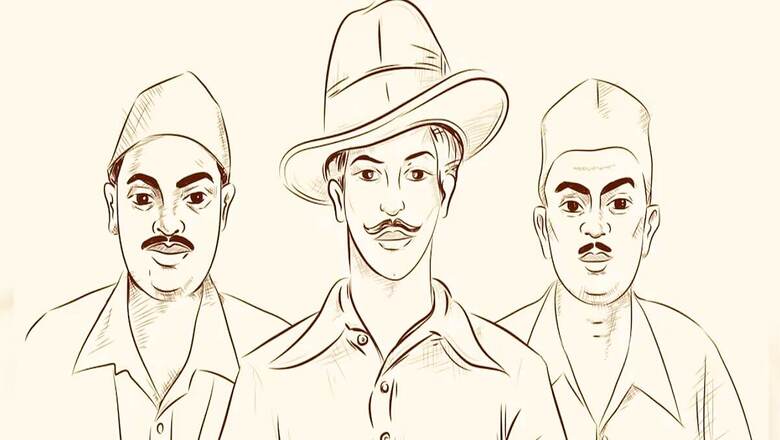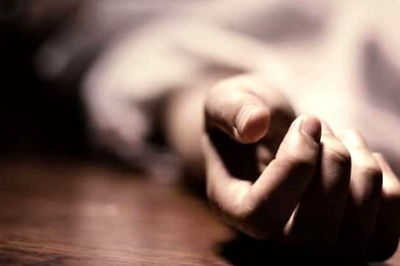
views
Bhagat Singh used to sow guns as a child in his family grounds of undivided Punjab in the previously undivided Bharat so that they would grow into firearms trees, which could be used in the annihilation of the British empire.
The trio – Bhagat Singh, Sukhdev Thapar and Shivaram Rajguru – were great patriots. They were directly guided by Chandra Shekhar Azad and indirectly by Veer Vinayak Damodar Savarkar. In fact, the Hindustan Socialist Republican Association’s (HSRA) mandatory reading material included ‘The Indian War of Independence 1857’. Bhagat Singh, Sukhdev Thapar, Shivaram Rajguru and Chandra Shekhar Azad were all members of the HSRA.
It must be remembered that independence was not attained by non-violence alone. It was not just Gandhi ji who fought for independence and got freedom for India. The violent struggles of Rash Behari Bose, Subhas Chandra Bose, Veer Damodar Savarkar, Chandra Shekhar Azad, Bhagat Singh, Sukhdev Thapar and Shivaram Rajguru were equally helpful in getting freedom for Bharat. Only fools would believe that we got independence only because of the ‘non-violent’ virtues of Jawaharlal Nehru and Mahatma Gandhi. Let us never forget that independence was attained because of the contribution of multiple freedom fighters with different ideologies.
Rash Behari Bose and Subhas Chandra Bose were major freedom fighters. RB Bose fought against the British sarkar and was the mastermind behind the Delhi conspiracy and the Ghadar conspiracy. The Ghadar conspiracy failed and Bose was to be arrested by the British but the former intelligently escaped to Japan. He founded the first Indian National Army during World War II. He had established himself well in Japan. He married the daughter of a powerful Samurai leader. Subhas Chandra Bose arrived in Singapore on July 2, 1943. He was warmly welcomed by RB Bose, who appointed Subhas as the leader of the Indian Independence League (IIL), which he had created. RB Bose held a conference of the Indian Independence League on July 4, 1943, wherein he delivered his final presidential address and praised Subhas extensively as a brilliant leader and uncompromising fighter. He resigned from the post of president of the IIL and appointed Subhas as its president. It was because of the humungous contributions of freedom fighters like RB Bose and Subhas Chandra Bose that Bharat got freedom.
The Jallianwala Bagh massacre took place on April 13, 1919. It was a horrific incident, which took place in Jallianwala in Punjab where General O’Dyer opened fire on innocent Bharatiya people. The impact of the Jallianwala Bagh massacre created many freedom fighters in Bharat.
The date March 23, 1931, is forever etched in the minds of the people of Bharat. On that day, three young freedom fighters, who were less than 25 years of age gave up their lives for their motherland. They were hanged by the British imperialists in Punjab. After hanging Bhagat Singh, Sukhdev Thapar and Shivaram Rajguru, their bodies were burnt using petrol and thrown into the Sutlej River by the cowardly British. However, people found out about it and recovered their bodies, which were later given a respectful adieu by our people.
In the days before Singh was to be hanged, he told his mother not to cry. For him, the motherland was greater than his mother. It was because of the devotion of such great people like Bhagat Singh, Sukhdev Thapar and Shivaram Rajguru that we are able to enjoy the fruits of freedom to such a great extent. Singh was reading a book just before being hanged, Thapar was singing songs and Rajguru was chanting mantras before their time of death. The trio willingly laid down their lives for their motherland as they wanted to inspire their brethren through their sacrifice. They were all less than 25 years old when they died for Bharat.
They all studied together at DAV, Lahore and were members of Naujawan Bharat Sabha and the Hindustan Socialist Republican Association. He was the chief of the Punjab unit of HSRA. He was involved in the assassination of Assistant Superintendent of Police, J.P. Saunders on December 17, 1928. Thapar was involved in the Lahore Conspiracy case and was mentioned as accused number one in the FIR filed by the then Senior Superintendent of Lahore, Hamilton Harding. In the FIR, he was described as ‘swami’, ‘peasant’, son of Ram Lal, Thapar Khatri caste. Thapar and his companions were detained, found guilty and given death sentences following the bombing of the Central Assembly Hall in New Delhi on April 8, 1929. Thus, Shivaram Rajguru, Sukhdev Thapar and Bhagat Singh were all hanged on March 23, 1931, in Lahore Central Jail.
National Martyrs Memorial is now located at Hussainwala where the trio were cremated. There is an Amar Shaheed Sukhdev Thapar Inter-State Bus Terminal at the birthplace of Sukhdev. There is also a Shaheed Sukhdev College of Business Studies in Delhi.
Veer Vinayak Damodar Savarkar was a great inspiration to this trio of martyrs. He became known as ‘Veer’ after an incidence of bravery in his childhood. Savarkar was indeed one of the bravest men in world history and the greatest patriot that the world has ever produced. The proof of this has been given by none other than former Prime Minister and poet Atal Bihari Vajpayee. In his own words of poetry, he said-
“सावरकर माने तेज, सावरकर माने त्याग, सावरकर माने तप।” (meaning Savarkar means speed, Savarkar means sacrifice and Savarkar means meditation).
One can understand the paramount significance of Veer Savarkar from the above lines. Savarkar contributed in multiple ways. First and foremost, he was a freedom fighter and patriot incomparable. His travails as a freedom fighter cannot be forgotten. His bravery in the face of excessive physical and mental torture should never be underestimated. Second, he was a grand litterateur. Savarkar was a poet, novelist, short story writer and playwright. He worked to purify the Marathi language. In Cellular Jail, Savarkar wrote another poem ‘Jayostute’ (Victory to you) in Marathi. He composed his first poem – ‘Swadeshichaphatka’ – when he was eleven. He wrote poems throughout his entire adult life. It is estimated that he wrote up to 6000 poems on the walls of his cell in Andaman and Nicobar Islands. His famous plays were ‘Usshap’, ‘Sanyastakhadga’ and ‘Uttarkriya’.
His contribution to Marathi literature is immense. He composed pawadas (ballads). One of his famous poems is Raarakaaspahun. He also wrote poems opposing the cruel practice of ‘untouchability’.
Third, he was also a very good historian, who had read countless books and keenly observed the independence movement in India. Savarkar wrote many books like ‘Joseph Mazini’ (biography of an Italian revolutionary), ‘1857 Che Swantantra Samar’ (the first Independence struggle of India of 1857), ‘Shikhancha Itihas’ (History of the Sikhs), ‘Mazi Janmathep’ (a narration of his jail term in the Andamans), ‘Sanyast Khadga’ (a play), ‘Kale Pani’ (Black Water), and many others. His other well-known books were ‘Hindupadpaadshaahi’ on Maratha history and ‘Six Glorious Epochs’.
Fourth, he was also a proponent of Hindutva philosophy. His book of 1922, ‘The Essence of Hindutva’ revolutionised the nation. He wrote the book in Ratnagiri jail. Hindutva as defined by Veer Savarkar is –“Everyone, who considers this land, from the river Sindhu till the sea as his or her fatherland/motherland and holy land is a Hindu.” His book, ‘Hindutva: Who is a Hindu?’ is yet another remarkable book.
Fifth, he worked to abolish the evil practice of untouchability. He believed that the caste system should be done away with to bring greater unity among the Hindus. Sixth, he called for a single unifying language to unite India. Seventh, he inspired countless freedom fighters like Madan Lal Dhingra, Chandra Shekhar Azad, Bhagat Singh, Sukhdev and SC Bose. Eighth, everyone appreciated the valour and greatness of Savarkar including the likes of RB Behari Bose – the founder of the Indian National Army, Subhas Chandra Bose – the successor of RC Bose and the legal luminary and champion of the socially depressed classes, BR Ambedkar. Ninth, Savarkar helped to design the first Indian national flag, which Madam Cama unfurled at the World Socialist Conference in Stuttgart, Germany.
Savarkar’s Views on Hindu Society
Savarkar said that seven shackles were keeping the Hindu society in chains, including Vedoktabandi. Vedoktabandi means keeping the sacred Vedas in chains. Savarkar believed that the knowledge regarding the Vedas was universal and that this knowledge could not be restricted to any one caste. He strongly believed that whosoever has the aptitude, discipline and desire should be allowed to study the Vedas. He also believed that there should be no Vyavasaaybandi or that no one should be forced to join any profession. Savarkar believed that a human should be free to choose their profession based on their talent, merit and nature.
The ancient practice of not letting Hindus travel overseas was not appreciated by Savarkar. He also considered Samudrabandi or the practice of not travelling overseas as a backward practice. He believed that Europe’s naval traditions were what made them strong. We must not forget that the Cholas of ancient Tamil Nadu were great naval powers in ancient Bharat. He also did not like the practice of Shuddibandi, which means the practice of not letting an individual reconvert into their mother religion (Gharwapsi). Savarkar believed that everyone should be allowed to return to their root religion. He also opposed Rotibandi. In other words, Savarkar favoured inter-caste dining. He was also against Betibandi and believed that there should be inter-caste marriages within the Hindu religion.
Savarkar had to endure many sufferings, cruelty, injustice, loss of domestic bliss, development of health issues and coping mechanisms due to his long years under torturous conditions in the dreaded Cellular Jail (Kaala Paani) at the Andaman Islands.
Veer Savarkar was illegally captured by the British on French soil and sentenced to two life imprisonments in the dreaded Kaala Paani. The British imperialists were very cunning and cruel rulers. They handed over two life imprisonment sentences (2 * 25 years) amounting to fifty years to Veer Savarkar. During that time, Savarkar (along with other political prisoners) was tortured in multiple horrendous ways (the painful description of which is beyond the capability of this sensitive author) for many years. Many political prisoners committed suicide, unable to bear the physical and mental torture by the English Jail authorities, who displayed animalistic pleasure in torturing hapless and weakened Bharatiya freedom fighters.
Meanwhile, Varanasi was a great hub of revolutionaries fighting to free Bharat Mata. The Hindustan Republican Association (HRA) was formed by Jogesh Chandra Chatterjee, Ram Prasad Bismil, Sachindranath Sanyal and Sachindra Nath Bakshi in 1924. Chandra Shekhar Azad came in contact with HRA through Rajendra Lahiri, Pranavesh Chatterjee and Manmath Nath Gupta. He became an active member and learnt to make bombs.
The revolutionaries were cruelly treated by the Britishers whereas members of the Indian National Congress were rather treated well. This was because the Congress did not really ‘fight’ against the British. The policy of ‘ahimsa’ suited the British. The British administrators, rulers, institutions and machinery felt safe with the ‘protests’ of the Congress. They got scared only after seeing the bravery of Bal Gangadhar Tilak, Veer Damodar Savarkar, Bhagat Singh, Chandra Shekhar Azad, RB Bose, Subhas Chandra Bose, Rajguru, Sukhdev Thapar and other revolutionaries. It is thus falsehood to think that Bharat became independent by purely adopting the principle of ‘ahimsa’ in its fight against the British.
We all know how finance, information, communication and logistics are the lifelines of organisations. Money was needed to run the Hindustan Socialist Republication Association. Ram Prasad Bismil, leader and revolutionary of HSRA came up with the idea to loot a train carrying Rs 30,000 of government money. The money was the money of the Bharatiya people which had been collected illegitimately by an imperialist regime. This plan was carried out in what later became famous as the Kakori train conspiracy case. The revolutionaries, who took part in the famous case, which took place on August 9, 1925, included Ram Prasad Bismil, Chandra Shekhar Azad, Ashfaqullah Khan, Rajendra Lahiri, Keshab Chakravarthy, Sachindra Bakshi, Manmath Nath Gupta and others The ‘8 down’ train carrying the money was travelling from Hardoi to Lucknow (present-day Uttar Pradesh). One of the revolutionaries pulled the emergency chain in the train as it approached Kakori. They overpowered the train guard and the heist was carried out. Ram Prasad Bismil and others were arrested. Some of those arrested were hung. Rajendra Lahiri, Ram Prasad Bismil, Ashfaqullah Khan and Roshan Singh were hung for conspiring in the Kakori Conspiracy.
HRA completely broke down after the Kakori incident. Azad escaped and a bounty of Rs 2000 was put on his head. There were lookout notices all over. He kept disguising himself to hide from the British-controlled Bharatiya police. He dressed up as a sage, a labourer, and a chauffeur among others. He kept moving to different places like Jhansi, Lucknow, Delhi, Lahore, and Varanasi amongst others.
Azad also loved playing games with the police. He would provoke them and often intimidate them. Azad promised himself that he would never be captured alive by them. In fact, during his period ‘in hiding’ and in disguise, he was able to acquire a driver’s licence issued by the police superintendent, himself. He was a person of great skills and intelligence. There are also various recorded instances of Azad coming to the rescue of the weak and vulnerable.
Later, Azad met Bhagat Singh. Singh was from Punjab and was the founder of the Revolutionary group, Navjeevan Sabha at Lahore. Punjab had been through the gruesome Jallianwala Bagh massacre in 1919. Earlier, the unjust Rowlatt Act passed by the Imperial Legislative Council in 1919 granted great powers to the government to repress political activities and allow for the detention of political prisoners without trial for two years. In March 1919, the Khilafat Committee had been formed. In December 1920, the Indian National Congress had adopted the Non-Cooperation Movement.
The two revolutionaries, Azad and Singh met at Delhi and soon formed a strong bond of friendship. They along with Sheo Varma, Mahaveer Singh, and Bhagawati Charan Vohra among others decided to give a new form and name to the Hindustan Republican Army in 1928. They called it the Hindustan Socialist Republican Association. Azad was unanimously chosen as the commander-in-chief of the HSRA.
The year was 1929. Lord Irwin was the Viceroy of India. He introduced two bills; the first was the Public Safety Bill and the second was the Trade Disputes Bill. The people were not happy with the high-handedness of the British rulers. Chandra Shekhar Azad came up with a plan to bomb the Central Assembly in Delhi and also to throw hand-outs. Bhagat Singh, the fiery revolutionary from Punjab was the person to bomb the Central Assembly. Singh along with Batukeshwar Dutt threw a bomb at the Assembly on April 8, 1929. The revolutionaries wanted to make the deaf British rulers hear the painful wailings of the suffering Bharatiya people under the cruel, exploitative, unjust, foreign and imperialist British rulers.
In October 1929, Lord Irwin made a vague offer of a ‘Dominion Status’ for India. However, our freedom fighters were not satisfied. The Congress demanded ‘Purna Swaraj’ or complete independence in December. Chandra Shekhar Azad was also indirectly involved in the attempt to blow up the Viceroy’s train in December 1929.
Mahatma Gandhi started the Civil Disobedience Movement on April 6, 1930, after he reached Dandi in Gujarat and had made salt. The Civil Disobedience Movement was called off after the Gandhi-Irwin Pact.
Thus, the first major action of the HSRA was the murder of JP Saunders to avenge the death of Lala Lajpat Rai and the second was the bombing of the Central Assembly by Bhagat Singh and Batukeshwar Dutt to protest against the Public Safety Bill and the Trade Disputes Bill.
To be continued
Dr. S Padmapriya, Ph.D, Author, Educator and Thinker, from Chennai. Views expressed in the above piece are personal and solely that of the author. They do not necessarily reflect News18’s views.




















Comments
0 comment